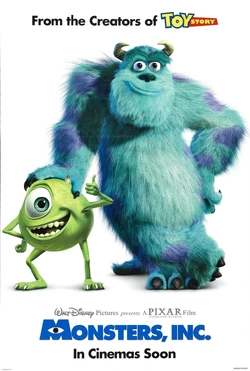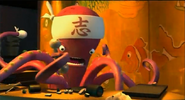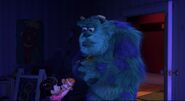
Cameos, in-jokes, re-used animation, and other trivia about Monsters, Inc..
Cameos[]
- When Randall gets banished near the ending, the setting is the same trailer setting from A Bug's Life, complete with the Pizza Planet truck which is parked next to it.
- A13 is also displayed rather than A113 on a pillar in the distance when Randall is getting thrown into the door he's banished to.
- The unicycle from Red's Dream appears on the Laugh Floor.
- Roly Poly Clown appears at the end.
- Boo has a Pixar ball, a Nemo toy, and a Jessie doll in her room.
- Rex appears in the outtakes.
- Randall turns the same color as Andy's bedroom paint job from Toy Story at one point.
- The wall behind the Octopus in Harryhausen's has Marlin from Finding Nemo on it.
- Nemo also appears on the door of the Trailer Son and Mom when Sulley throws Randall into it.
- The toy plane from Toy Story appears on the top left of the shelf in the little boy's bedroom at the beginning.
- There is a sticker of a beaver from Toy Story 2 on a child's door after Randall comes out of it, scaring a child. The beaver is a critter from Woody's Roundup.
Cameos Gallery[]
A113 spelled out in the stars, and the Pizza Planet truck to the left.
Roly Poly Clown from Toy Story and Toy Story 2 appears in the end.
Red the unicycle on the Laugh Floor.
Other trivia[]
- The year the film takes place is seen to be 1999 (as seen here in this folder).
- Sulley has 2,320,413 individual strands of hair.[1] 25,336 of them are "key" hairs, which are used to guide the motion and shape of the other 2,295,077 hairs. A technical director hand animated the hairs on his fingers to make them react to Boo's touch near the end of the movie.[2]
- The letters "FIZT" on the door machine come from an application developed to control the movement of Sulley's fur based on his actions and other factors such as wind.[1]
- The name for Mike Wazowski came from the father of the Muppet performer Frank Oz.[1]
- In one of the children's bedrooms at the end of the film, posters for Disneyland's Sailing Ship Columbia and Tomorrowland are seen.
- Randall Boggs, voiced by Steve Buscemi, at one point says to Fungus, "If I don't see a new door in my station in five seconds, I will personally put you THROUGH THE SHREDDER!" Buscemi starred in Fargo, a movie in which his character gets put through a wood chipper/shredder by his murderous accomplice.
- On the top scarers leader board, under Sulley and Randall, is a monster named Ranft. This was probably to Joe Ranft, who is one of Pixar's storyboard artists. He also did a couple of voices in films.
- All of the Scarers' last names except for Sulley, Randall, George Sanderson and Ricky Plesuski are also those of actual Pixar staff members.
- The Hidden City Cafe (located in Richmond) is seen in the opening scene, which, according to a teaser trailer for WALL•E, is where they thought up the idea for Monsters, Inc, A Bug's Life, Finding Nemo, and WALL•E. In the Filmmakers's Round Table feature on the Blu-ray release of the movie, Pete Docter revealed the movie was originally named "Hidden City" because the Café "was basically the Pixar commissary for a lot of us".
- The scene where Sulley thinks that Boo has been crushed to death in a trash compactor references the Looney Tunes short Feed the Kitty, right down to Sulley even mimicking Marc Anthony the bulldog's reactions to "Boo"/"Pussyfoot" being "shredded alive" by the compactor/"cooked alive" in an oven and subsequently lamenting her "death" after retrieving a garbage cube containing one of Boo's costume's "eyes"/cookie shaped like a cat.
- The preschool teacher who brings her class to the Monsters, Inc. factory during Boo's escapades inside the factory and blending into said class is named Ms. Nesbit, after a throwaway gag in Toy Story in which Hannah Phillips assigns that name to Buzz Lightyear after Buzz attempts to fly out of a window after learning the truth about him not being a flying toy after watching a TV commercial about his toy brand only to fall off the balcony and crashing onto the first floor and severing his left arm, before being rescued by Hannah and turned into one of her "dolls."
- This is the first Pixar film not to be directed by John Lasseter.
- This is the only Pixar film to shorten the opening logos.
- This film marks Pixar's 15th anniversary.
- This is the only Pixar film directed by Pete Docter to be rated G by the MPAA since Up, Inside Out and Soul were all rated PG.
- This is also the first Pixar film of the 21st Century and the 3rd Millennium as well as the first to air in the 2000s.
- This is the third and final Pixar film to have outtakes at the end of the film.
- This is the first (and to date only) film directed by Pete Docter to be scored by Randy Newman, with Up and Inside Out being scored by Michael Giacchino, as well as Soul being scored by Trent Reznor and Atticus Ross.
- There are two different versions of the end credits. The original end credits, which feature stylized monster and door designs akin to the opening credits, was used during the first month of its initial theatrical run, as well as the 2002 Region 1 DVD release when Widescreen is selected, the 2009 and 2013 Blu-Ray’s, the 2020 UHD Blu-Ray, and current digital, TV, and Disney+ prints. The second version, which features the Outtakes and Company Play, was added on December 7, 2001, and is still present on current theatrical re-releases. This also is shown all worldwide VHS releases, the Region 1 DVD when Fullscreen is selected, international DVD releases, and some TV broadcasts until the mid-2010’s.
- All of the digital displays (such as the clock radio, the "Days since the last accident" counter, etc.), are all made up of Nixie tubes. Nixie tubes were digital displays made up of digits formed from light bulbs with wiring shaped like letters or numbers, much like neon signs.
- It's Pixar's first attempt at simulating loose clothing like skirts and dresses (in this case, Boo's nightshirt). In the first two Toy Story films, all human girls and women, (Ms. Davis, Hannah Phillips) wore pants since it was very difficult at the time to animate skirts and dresses, Bo Peep's dress included a hoop skirt, and the various Barbie dolls were all seen wearing tight clothing.
- This is the only Pixar film whose original VHS and DVD releases lacked a paperboard slipcover.
- There are at least 100 different monster "races" seen in the film.
- Due to software limitations, the artists were mostly limited to 1 hairy character per shot.[3]
- This film was nominated for the first Academy Award for Best Animated Feature in 2001, but lost to a DreamWorks film named Shrek. This makes Pixar one of the first three animation studios to be nominated for that category.
- This is the first Pixar film to mute the beginning of the Disney and Pixar opening.
- Before Billy Crystal got the role of Mike, he was given the option to voice Buzz Lightyear for Toy Story but decided not to. After he saw the film, he said that he made a big mistake. Pixar said that if anything were coming up that they will consider him. When he was given the option to do this film, he immediately said yes.
- This was the only Pixar film that featured a blue VHS tape instead of black.
- This is the first Pixar film that has a feature-related short film, Mike's New Car.
- The code 2319 stands for White Sock - W is the 23rd letter in the alphabet and S is the 19th letter.[4]
- 90% of all the monsters in the film have Mike's tongue.[2]
- Sometime in 1999, the producers had a hard time getting Mary Gibbs, Boo's voice actress, to get her voice recorded because they couldn't get her to stand still at the microphone. They ended up carrying a microphone around her when she played the character. She was 5 years old by the time Monsters, Inc. was released in theaters
- The amplifier in Mike and Sulley's apartment has controls for Bass and Perch (instead of Treble). Both bass and perch are common fish found in northern America, including Minnesota. Minnesota is Pete Docter's home state.
- During the scene where Mike and Sulley walk to work, that day's Monstropolis Horn is shown in a vending machine. With the Blu-ray release of the movie, the articles on the front page are just legible enough to recognize that the same text was used for both the "Scream Shortage Looms" and "Modern Kis Harder to Scare".
- This is the first Pixar film to have (Created And Produced At - Pixar Animation Studios - Emeryville, California), since the studio had moved to Emeryville from Point Richmond in 2000.
- According to Albert Lozano's file, human world is set in 1999.
- As stated by Pete Docter in the Filmmakers' Round Table feature, "every sequence that's now impossible to do is called 'The Yeti's Cave'" in honor of both how technically difficult it was to animate the snowstorm and its effects on Sully, as well as the difficulty in developing the sequence where Mike and Sully meet the Yeti.[5]
- The Utah teapot can be seen on the table in Boo's bedroom.
- In the international version, during the 2319 scene, there is a signal with a picture of a person, but in some frames, the original "Warning: Contamination Alert" is visible.
- This is the first Pixar film to not feature a Woody cameo, as Toy Story and Toy Story 2 had him as a main character, and A Bug's Life had him at the end credits.
Other trivia Gallery[]
References[]
- ↑ 1.0 1.1 1.2 Price, David A. (2008). The Pixar Touch, pp. 197-200. New York, Alfred A. Knopf
- ↑ 2.0 2.1 The Science Behind Pixar Fun Facts
- ↑ Episode 13 of the Pixar Post Podcast - Monsters University Press Day Part 3 of 3
- ↑ Jonathan Feldman tweet, SIGGRAPH Renderman presentation, 2015
- ↑ "Filmmakers' Round Table" featurette on the Blu-ray release of Monsters, Inc.












